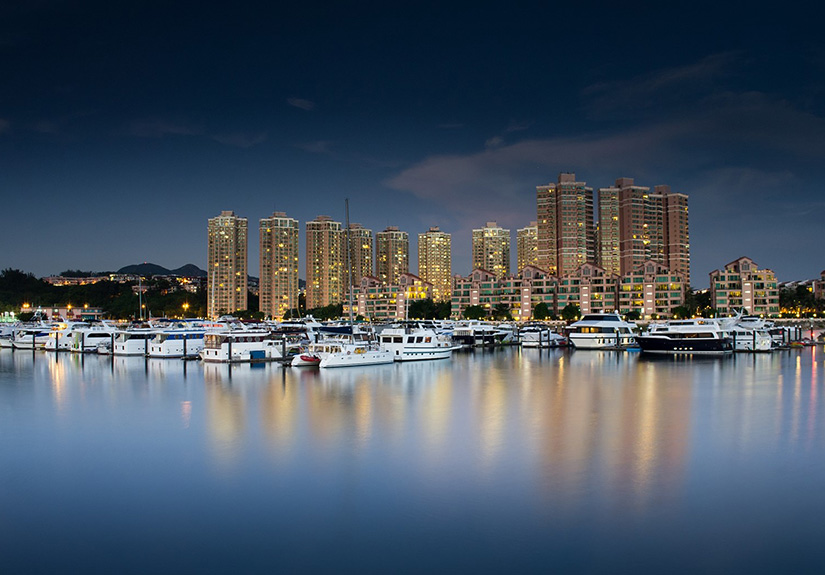Capture the Romantic After-Rain Scenes
Top 3 Shooting Tips for Reflection Photography
Although summer in Hong Kong is a rainy season, there is always something interesting to shoot with the rains. Whether you are a landscape or streetscape lover, you can make good use of reflections to enrich your photos and open up room for imagination! Let’s check out the top 3 shooting tips for beautiful reflection shots shared by landscape photographer CP Lau @MUG Photography.

Search for Calm Water Surface
Reflections are commonly used technique in landscape photography. To make use of the reflective nature of water, first we need to have a calm water surface. The more the water sits still, the nicer reflections showing clear sky and the surrounding scenery we can get. In general, wind is weakest in early morning. As long as there is enough ambient light, nice reflection shots can be obtained simply by pressing the shutter without any special technique. CP said, “The dawn and dusk are usually the most ideal time in a day for reflection photography. The reflections of the vivid colors of the sky in water can greatly enhance your photos.”

When photographing scenes with huge lighting contrast such as sunrise and sunset, problems of a dim foreground and lack of details may arise due to the high brightness level of the sky. To solve these problems, apart from using a Graduated ND Filter to balance out the lighting contrast, we can also make use of the puddles of water to include the sky reflections for a better exposure result.

Photographed at Lau Fau Shan
Photo by CP Lau
EOS-1D X • EF 16-35mm f/2.8L II USM • 1/2000s • f/8 • ISO 400
Photo by CP Lau
EOS-1D X • EF 16-35mm f/2.8L II USM • 1/2000s • f/8 • ISO 400
Use of 50/50 Composition
In general, the 50/50 composition technique is used to create the perfect reflection photo by having the actual scenery and the reflections taking up half of the frame respectively. Turn on the camera’s electronic level or gridlines to assist your framing for more symmetrical result. To create depth to the photos, we can take a few steps further to the side of the lake or pond so that the subject can be positioned off-center for a stronger sense of depth. “We can get closer to the ground to shoot from a lower angle. This can include more landscape in the framing as well as making the reflections more complete. In addition to landscape, it’s also a good idea to add some human figures in your reflection photos to liven things up.”

Photographed at the Western District Public Cargo Working Area in Sai Wan
Photo by CP Lau
EOS-1D X • EF 16-35mm f/2.8L II USM • 1/2000s • f/8 • ISO 400
Photo by CP Lau
EOS-1D X • EF 16-35mm f/2.8L II USM • 1/2000s • f/8 • ISO 400
Show More Depth by Using Front Lighting
The lighting direction is important too when it comes to reflection photography. A front or side lighting can best bring out the sense of depth and distance of all objects in the frame. Since reflection in water is a kind of reflected light, which has a substantial difference in brightness when compared with the direct ambient light, the sky will get over-exposed easily especially on a sunny day when both the sky and reflection are taken. To deal with this, the most straight forward way is to use a Graduated ND Filter to balance the brightness of the upper and lower parts so as to retain details in both highlight and shadow areas.
We may come across beautiful scenery at any time. What can we do if it so happens that we don’t have a Graduated ND Filter? A suggestion from CP is to shoot with the RAW format so we can have more freedom in post-editing. “Today’s technology allows us to effectively increase the brightness level of the shadow area during post-editing. This makes a good way to achieve balance in lighting contrast too.”
We may come across beautiful scenery at any time. What can we do if it so happens that we don’t have a Graduated ND Filter? A suggestion from CP is to shoot with the RAW format so we can have more freedom in post-editing. “Today’s technology allows us to effectively increase the brightness level of the shadow area during post-editing. This makes a good way to achieve balance in lighting contrast too.”

Photographed at the Western District Public Cargo Working Area in Sai Wan
Photo by CP Lau
EOS 5D Mark III • EF 16-35mm f/2.8L II USM • 1/125s • f/11 • ISO 100
Photo by CP Lau
EOS 5D Mark III • EF 16-35mm f/2.8L II USM • 1/125s • f/11 • ISO 100
Search for “Mirror of the Sky” in the City
Where should we go in Hong Kong for reflection photography? The more popular destinations include Lau Fau Shan, the Western District Public Cargo Working Area in Sai Wan, Nam Shan Estate, the West Kowloon Waterfront Promenade and Chun Yeung Street in North Point. In fact, puddles of water that form on uneven ground after rain make good photographic subjects as well. The glass curtain walls of buildings, a marble floor are also good reflective surfaces. As long as you observe closely, reflections can be everywhere!

Use of a slow-speed shutter and tripod can result in smooth water surface and a clear reflection with sufficient exposure
Photo by CP Lau
EOS-1D X • EF 16-35mm f/2.8L II USM • 2.5s • f/9 • ISO 100
Photo by CP Lau
EOS-1D X • EF 16-35mm f/2.8L II USM • 2.5s • f/9 • ISO 100
One of the recommended locations by CP is Ha Pak Nai in Yuen Long. “The landscape in Ha Pak Nai is very special, but it requires more preparation work before going. First, we have to check the Predicted Tides at Tsim Bei Tsui on the Hong Kong Observatory website so we know at what time the water recedes. Theoretically, it’s better to go at sunset hours. Because the coastline of Ha Pak Nai are all mudflats, casual outfit such as shorts and sandals is more appropriate. And to keep your tripod from getting mud stained, you can cover its feet with plastic bags.”



